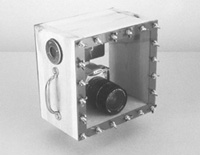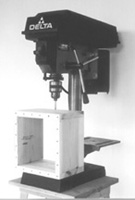Do It Yourself
Build An Underwater Camera Housing
I've been thinking about this month's project for years, but its complexity kept me from presenting it until now. The features of current AF SLR cameras allow the design to be greatly simplified and made practical for the home workshop but, because a high degree of accuracy is required in construction and a drill press is needed, I'm declaring it a Level 4 project. For those who just joined us, Level 1 takes only everyday items and the ability to assemble, say, a plastic model kit. Level 2 requires basic hand tools and the skill to perhaps build a small birdhouse from scratch. Level 3 uses home improvement tools and the hands-on savvy to install a wall thermostat, with Levels 4 and 5 reserved for mechanically nimble readers who might enjoy putting in their own car sound system or overhauling their brakes. Disclaimer: Please Read |
|||
However, the many variables involved in materials, construction, and use prevent the author and/or Shutterbug from accepting any responsibility for water or other damage to your equipment should the project fail in any way. Please read the entire article carefully before beginning, and test the finished housing as described before taking it underwater with your camera inside. As these variables also make a maximum safe operating depth impossible to determine, consider it a shallow-water (20 ft or less) housing unless your tests prove otherwise. Project Setup |
|||
Tub Test The first test is done with the tub dry. Place a folded washcloth in the container so that the camera and lens rest evenly against the bottom. Set the camera to aperture-priority auto mode, open the aperture all the way, turn autofocus on and connect the remote release. Take a picture of the test target by existing light, not flash. (Program mode is likely to activate the built-in flash of many cameras.) Be sure not to jar the camera or container during exposure and blur the image. The second test is done with the tub filled. Keeping everything as before, make another exposure of the target. Run the film to a minilab and examine the prints. Both should be in sharp focus and correctly exposed, although the target in the underwater shot will appear closer, as if taken with a 50mm lens. (This is caused by refraction differences between air and water.) If the underwater image made with a zoom lens is out of focus, add a +4 close-up lens and repeat the underwater test. |
|||
The Housing Build the housing from sound, unwarped wood. Carefully cut and fit the pieces so that the joints are without gaps, and glue them thoroughly keeping all edges even. Drill a 5/8" hole for the remote release and, being mindful of the earlier positioning considerations, a 5/16" hole for the camera fastening screw. These are the only holes that go all the way through--all others (handle screw holes, etc.) must not penetrate the housing as in Diagram C. |
|||
Acrylic Sheets Using a drill press, drill the acrylic with a sharp bit. (A scrap of board beneath it minimizes the chance of cracking.) Align the sheets on their respective sides of the housing and trace the hole pattern onto the wood. Drill the proper size hole for the wood screw thread of the hanger bolts. The hardness of the wood will dictate the exact drill bit size for a tightly threaded fit, but it will definitely be smaller than the 1/4" acrylic clearance holes. The Gaskets Marine Varnish Leak Test After Use |






































